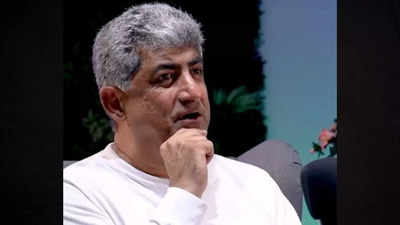- News
- lifestyle
- soul-search
- Exploring ancient spiritual traditions and how to adopt them in modern life
Trending
Exploring ancient spiritual traditions and how to adopt them in modern life
Ancient spiritual traditions emphasize self-realization through Sanatana Dharma, teaching that individuals are Divine Souls, not just human beings. They guide towards realizing the ultimate purpose of life by questioning 'Who am I?' and understanding concepts like Neti Neti and Tat Twam Asi.

Are ancient spiritual traditions still relevant in today's life or are they old-fashioned, out of date and irrelevant? How can we adopt these traditions in modern life today so that we can live with peace, love and bliss?
One thing hasn't changed over the years. Everybody wants to be happy. The world has changedconsiderably but our ultimate seeking is the same.Neither has anything changed in terms of life and death. The body is born and it will die. Ancient traditions tell us that birth and death are related to Karma. The Law of Karma makes us live a life of good values, virtues, morals and ethics because if we don't do good Karma, we will suffer. Our Karma, as per ancient traditions and wisdom, has to do with Dharma. Today, the world pays little heed to Dharma and therefore, we have gone off track.
The Purushartha or the purpose of life was stated as being: Dharma (righteousness), Artha (prosperity), Kama (pleasures and desires) and Moksha (liberation from the cycle of death and rebirth). Today, while we still talk of Moksha, we don't understand the true meaning of Moksha. We all want Artha and we are
consumed by Kama. We want money and we have desires, but we have lost our focus on Moksha. The ancient spiritual traditions used to talk of the 4 Ashrams of life: Brahmacharya, Grihastha, Vanaprastha and Sanyas.
Then ultimately, one would take up Sanyas, which means completely dedicating oneself to finding the purpose of life, to Moksha. But today, what we do is that we learn and then we earn. This is as good as the stages of Brahmacharya and Artha. We even follow Grihastha. But today, we learn, we earn, then we die, we
burn and we return. In the olden days, we used to learn and earn. Then we used to turn and yearn for the Divine, yearn for the purpose of our existence.
Ultimately, what is all this about? The ancient spiritual traditions told us that the purpose of life is to realize, ‘Who am I and why am I here?’ Neti Neti, Tat Twam Asi: You are not the body, you are not the mind. You are that. You are the Divine Soul.
The ancient spiritual traditions used to tell us that this world is Maya, an illusion, it's Mithya — Jagat Mithya. Brahman was the universal Supreme Power — Brahman Satya. This meant that the whole world is a manifestation of the one Divine. We are God. Aham Brahmasmi. Tat Twam Asi. Shivoham. Spiritual
traditions urged us to realize that we are not human beings. We are the Divine Soul.
Unfortunately, most of us in today’s world do not achieve this goal. In fact, we don’t even realize that this is the goal of life.We think that success is happiness. We think achievement is purpose. We don't reach that state of fulfillment and contentment. Therefore, modern day man is far unhappier than man in olden days because even though in olden times, there were lesser pleasures and life was simple, man had fewer
desires and passions.
Today man is running like a madman. Man is in a race to become an ace and is caught in a maze in
this chase. In olden times, man lived with grace. Therefore, if we want to follow these ancient spiritual traditions, we should slow down our pace. If we slow down our pace and go back to the teachings of Sanatana Dharma, which is not a religion, but our original way of life, our original philosophy, then
we will be able to live a life of peace, of love, of bliss, discovering the self. Self-Realization will lead to God Realization and will make us one with the Divine.
Of course, there are certain spiritual practices and traditions that modern man seems to be following. Yoga, for instance. However, Yoga is more than just Asanas or physical exercises or Pranayama or breathing techniques. Today there all kinds of Yoga studios in the world but they actually have very little to do
with the true meaning and purpose of Yoga. Yoga comes from the word, Yuj and it means to be in union with God. It is only when we are in Yoga, living as a true Yogi that we can attain the ultimate purpose of life.
One can be in Yoga, everconnected with the Divine through Dhyana Yoga (meditation), Bhakti Yoga (devotion), Karma Yoga (action), Gyana Yoga (education), Prema Yoga (the Yoga of Divine Manifestation).
Meditation is another age-old tradition that must be followed to transcend the mind and be in the state of Consciousness. It is in the state of Consciousness that we can realize the truth. But meditation is not about going out into a forest and sitting under a tree, cross-legged. Meditation is about making the mind still
and it can be done right inside our homes or even our place of work, sitting in a comfortable position, any time of the day when we know that we will not be disturbed.
Spiritual traditions are meant to guide us, to bring us out of the darkness of ignorance and help us live in the light of the truth, in peace, bliss and joy. They lead us to the ultimate purpose of life. They can completely transform us and it is important that we try to follow them.
By AiR - Atman in Ravi : Happiness Ambassador, Author, Spiritual Mentor and Philanthropist
One thing hasn't changed over the years. Everybody wants to be happy. The world has changedconsiderably but our ultimate seeking is the same.Neither has anything changed in terms of life and death. The body is born and it will die. Ancient traditions tell us that birth and death are related to Karma. The Law of Karma makes us live a life of good values, virtues, morals and ethics because if we don't do good Karma, we will suffer. Our Karma, as per ancient traditions and wisdom, has to do with Dharma. Today, the world pays little heed to Dharma and therefore, we have gone off track.
The Purushartha or the purpose of life was stated as being: Dharma (righteousness), Artha (prosperity), Kama (pleasures and desires) and Moksha (liberation from the cycle of death and rebirth). Today, while we still talk of Moksha, we don't understand the true meaning of Moksha. We all want Artha and we are
consumed by Kama. We want money and we have desires, but we have lost our focus on Moksha. The ancient spiritual traditions used to talk of the 4 Ashrams of life: Brahmacharya, Grihastha, Vanaprastha and Sanyas.
We had to move, evolve from one stage to another. Young children would study at a Gurukul, a tradition which no longer exists. Now, we go to modern schools. In the olden days, after Brahmacharya, one would step into Grihastha, get married and have a family. But after one turned 50-years-old, one would step back from the material world to enter the stage of Vanaprastha. This would imply renunciation of material life, the relinquishment of household duties and focusing on spiritual pursuits.
Then ultimately, one would take up Sanyas, which means completely dedicating oneself to finding the purpose of life, to Moksha. But today, what we do is that we learn and then we earn. This is as good as the stages of Brahmacharya and Artha. We even follow Grihastha. But today, we learn, we earn, then we die, we
burn and we return. In the olden days, we used to learn and earn. Then we used to turn and yearn for the Divine, yearn for the purpose of our existence.
Ultimately, what is all this about? The ancient spiritual traditions told us that the purpose of life is to realize, ‘Who am I and why am I here?’ Neti Neti, Tat Twam Asi: You are not the body, you are not the mind. You are that. You are the Divine Soul.
The ancient spiritual traditions used to tell us that this world is Maya, an illusion, it's Mithya — Jagat Mithya. Brahman was the universal Supreme Power — Brahman Satya. This meant that the whole world is a manifestation of the one Divine. We are God. Aham Brahmasmi. Tat Twam Asi. Shivoham. Spiritual
traditions urged us to realize that we are not human beings. We are the Divine Soul.
Unfortunately, most of us in today’s world do not achieve this goal. In fact, we don’t even realize that this is the goal of life.We think that success is happiness. We think achievement is purpose. We don't reach that state of fulfillment and contentment. Therefore, modern day man is far unhappier than man in olden days because even though in olden times, there were lesser pleasures and life was simple, man had fewer
desires and passions.
Today man is running like a madman. Man is in a race to become an ace and is caught in a maze in
this chase. In olden times, man lived with grace. Therefore, if we want to follow these ancient spiritual traditions, we should slow down our pace. If we slow down our pace and go back to the teachings of Sanatana Dharma, which is not a religion, but our original way of life, our original philosophy, then
we will be able to live a life of peace, of love, of bliss, discovering the self. Self-Realization will lead to God Realization and will make us one with the Divine.
Of course, there are certain spiritual practices and traditions that modern man seems to be following. Yoga, for instance. However, Yoga is more than just Asanas or physical exercises or Pranayama or breathing techniques. Today there all kinds of Yoga studios in the world but they actually have very little to do
with the true meaning and purpose of Yoga. Yoga comes from the word, Yuj and it means to be in union with God. It is only when we are in Yoga, living as a true Yogi that we can attain the ultimate purpose of life.
One can be in Yoga, everconnected with the Divine through Dhyana Yoga (meditation), Bhakti Yoga (devotion), Karma Yoga (action), Gyana Yoga (education), Prema Yoga (the Yoga of Divine Manifestation).
Meditation is another age-old tradition that must be followed to transcend the mind and be in the state of Consciousness. It is in the state of Consciousness that we can realize the truth. But meditation is not about going out into a forest and sitting under a tree, cross-legged. Meditation is about making the mind still
and it can be done right inside our homes or even our place of work, sitting in a comfortable position, any time of the day when we know that we will not be disturbed.
Spiritual traditions are meant to guide us, to bring us out of the darkness of ignorance and help us live in the light of the truth, in peace, bliss and joy. They lead us to the ultimate purpose of life. They can completely transform us and it is important that we try to follow them.
By AiR - Atman in Ravi : Happiness Ambassador, Author, Spiritual Mentor and Philanthropist
The Secret of Karma Yoga in Bhagavad Gita Chapter 3, Verse 11
End of Article
FOLLOW US ON SOCIAL MEDIA










